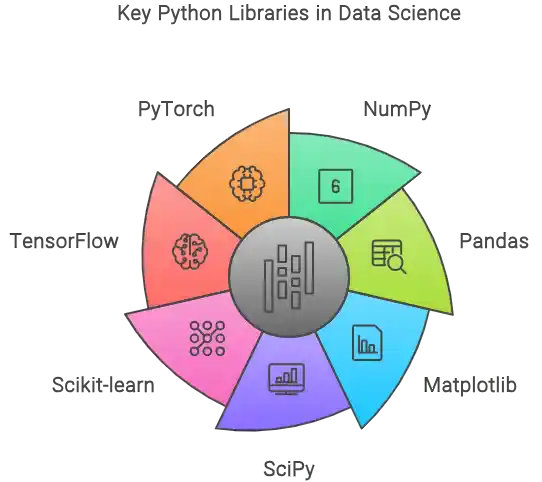Table of Contents
In the world of programming languages, Ruby vs Python stand out as two of the most popular and versatile options. Both have their unique strengths, community support, and areas of application. However, Python has gained a significant edge in recent years due to its simplicity, readability, and extensive range of applications. This comprehensive guide will delve into the “Ruby vs Python” debate, highlighting why Python has become the preferred choice for many developers.
Introduction to Ruby and Python
Ruby
Ruby is an open-source programming language created by Yukihiro “Matz” Matsumoto in the mid-1990s. It is known for its simplicity and productivity, combining parts of Perl, Smalltalk, Eiffel, Ada, and Lisp. Ruby’s syntax is designed to be intuitive and natural to read and write. The language’s most famous framework, Ruby on Rails, has been instrumental in its popularity, particularly for web development.
Python
Python, created by Guido van Rossum and released in 1991, is a high-level, interpreted language known for its readability and simplicity. Python’s design philosophy emphasizes code clarity and simplicity, making it an ideal choice for both new and experienced developers. Python supports a variety of programming paradigms, including procedural, object-oriented, and functional programming. Its extensive standard library and thriving community have made it a staple in various domains, from web development to data science.
Comparison Table: Ruby vs Python
| Feature | Ruby | Python |
|---|---|---|
| Creation | Created by Yukihiro “Matz” Matsumoto in the 1990s | Created by Guido van Rossum, released in 1991 |
| Syntax | Elegant and expressive, flexible but inconsistent | Simple and readable, enforced indentation |
| Primary Web Framework | Ruby on Rails | Django, Flask |
| Community and Ecosystem | Strong, niche community, mainly around Rails | Large, active, diverse, extensive libraries |
| Data Science & ML | Limited ecosystem | Extensive libraries like NumPy, Pandas, TensorFlow |
| Performance | Slower in CPU-bound tasks | Better performance with C extensions and JIT |
| Package Management | RubyGems | PyPI |
| Readability | High but less enforced | Very high, enforced by design |
| Learning Curve | Moderate | Easy |
| Popular Use Cases | Web development, prototyping | Web development, data science, machine learning |
Syntax and Readability
One of the primary considerations when comparing Ruby vs Python is their syntax and readability.
Ruby Syntax
Ruby’s syntax is often described as elegant and expressive. It aims to make code as readable and concise as possible. Ruby code tends to be more flexible, allowing developers to express ideas in multiple ways. However, this flexibility can sometimes lead to inconsistency in code style among different developers.
For example, a simple Ruby method might look like this:
rubyCopy codedef greet(name) “Hello, #{name}!” endPython Syntax
Python’s syntax, on the other hand, is straightforward and emphasizes readability. Python uses indentation to define code blocks, which enforces a consistent coding style and reduces the likelihood of errors. This design choice makes Python code easy to read and understand, even for those new to programming.
Here’s the same method in Python:
pythonCopy codedef greet(name):
return f"Hello, {name}!"
Python’s simplicity and readability often make it the preferred choice for beginners and those who value clear, maintainable code.
Community and Ecosystem Ruby vs Python
Ruby vs Python Community and Ecosystem Both Ruby and Python have strong communities and ecosystems, but there are some differences worth noting.

Ruby Community and Ecosystem
Ruby has a passionate and active community, particularly around Ruby on Rails. Rails is a powerful web development framework that has driven much of Ruby’s popularity. The RubyGems package manager provides access to a wide range of libraries and tools, making it easy to extend Ruby’s functionality.
However, Ruby’s community and ecosystem are more niche compared to Python. While Ruby on Rails remains a popular choice for web development, Ruby’s presence in other domains is less pronounced.
Python Community and Ecosystem
Python boasts one of the largest and most active programming communities in the world. Its extensive ecosystem includes a vast array of libraries and frameworks for web development (Django, Flask), data science (NumPy, Pandas, Matplotlib), machine learning (TensorFlow, sci-kit-learn), and more. The Python Package Index (PyPI) hosts over 300,000 packages, ensuring that developers can find tools and libraries for almost any task.
Python’s community is known for its inclusivity and support, making it an excellent environment for learning and collaboration. The language’s versatility and extensive ecosystem have contributed to its widespread adoption across various industries.
Web Development Ruby vs Python
In Ruby vs Python, Web development is a common use case for both Ruby and Python, and each language has its own strengths in this area.
Ruby on Rails
Ruby on Rails (often referred to as Rails) is a powerful and opinionated web framework that emphasizes convention over configuration. Rails is designed to make web development fast and straightforward by providing a robust set of tools and best practices out of the box. Rails’ focus on convention helps developers avoid common pitfalls and speeds up the development process.
Rails applications often follow a specific structure, which can be advantageous for team collaboration and maintaining code quality. However, Rails’ opinionated nature can be limiting for developers who prefer more flexibility in their projects.
Django and Flask
Python offers several web frameworks, with Django and Flask being the most popular.
Django
Django is a high-level web framework that encourages rapid development and clean, pragmatic design. Like Rails, Django follows the “batteries-included” philosophy, providing a wide range of built-in features and tools. Django’s admin interface, ORM, and authentication system are particularly well-regarded.
Django’s emphasis on security and scalability makes it a popular choice for large-scale web applications. Its clear documentation and strong community support further enhance its appeal.
Flask
Flask is a micro-framework that offers greater flexibility than Django. It provides the essential tools needed to build web applications while allowing developers to choose their preferred components and extensions. Flask’s minimalist approach is ideal for small to medium-sized projects or those requiring a more customized setup.
Flask’s simplicity and flexibility make it a favorite among developers who want more control over their application’s architecture.
Data Science and Machine Learning
One of the key areas where Python has gained a significant advantage over Ruby is in data science and machine learning.

Python’s Dominance in Data Science
Python’s ecosystem includes a wealth of libraries and frameworks specifically designed for data analysis, visualization, and machine learning. Some of the most notable ones include:
- NumPy: A library for numerical computing with powerful array objects.
- Pandas: A data manipulation and analysis library that provides data structures like DataFrames.
- Matplotlib: A charting package for creating static, animated, and interactive visualizations.
- SciPy: A library for scientific and technical computing.
- Scikit-learn: A machine learning library that offers easy and effective tools for data mining and analysis.
- TensorFlow and PyTorch are deep learning frameworks used to create and train neural networks.
These libraries, combined with Python’s ease of use and readability, have made Python the de facto language for data science and machine learning. The language’s ability to handle complex mathematical computations and its integration with other scientific tools have further solidified its position in this field.
Ruby in Data Science
While Ruby has some libraries for data manipulation and analysis (such as Daru and NMatrix), its ecosystem is not as mature or extensive as Python’s. Ruby’s use in data science is relatively limited, and most data scientists and machine learning practitioners prefer Python for its robust tools and community support.
Performance Ruby vs Python
Performance is another important factor to consider in the “Ruby vs Python” debate.
Ruby Performance
Ruby is often criticized for its performance, particularly in CPU-bound tasks. While Ruby on Rails can be performant for web applications, the language itself is generally slower than many other programming languages. Efforts like JRuby (a Java implementation of Ruby) and other performance enhancements have helped, but Ruby is still not the first choice for performance-critical applications.
Python Performance
Python is also known for its performance limitations, especially in CPU-bound tasks. However, Python’s performance can be significantly improved through various means, such as using C extensions (e.g., NumPy) or employing Just-In-Time (JIT) compilers like PyPy.
For most applications, Python’s performance is sufficient, and its readability and ease of use outweigh the performance concerns. In cases where performance is critical, developers can use optimized libraries or integrate Python with other high-performance languages like C or C++.
Conclusion
The “Ruby vs Python” debate ultimately comes down to the specific needs and preferences of the developer or the project at hand. Both languages have their strengths and areas of application, but Python’s simplicity, readability, and extensive ecosystem have made it the preferred choice for many developers.
Python’s dominance in data science, machine learning, and its versatility across various domains have further cemented its position as a leading programming language. While Ruby remains a strong contender, particularly in web development with Ruby on Rails, Python’s broad appeal and powerful libraries make it the go-to language for a wide range of applications.
In the end, both Ruby vs Python offer unique benefits, and the choice between them should be based on the specific requirements of the project and the developer’s familiarity with the language.